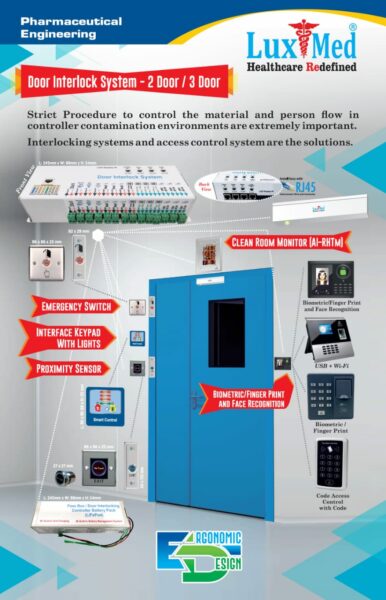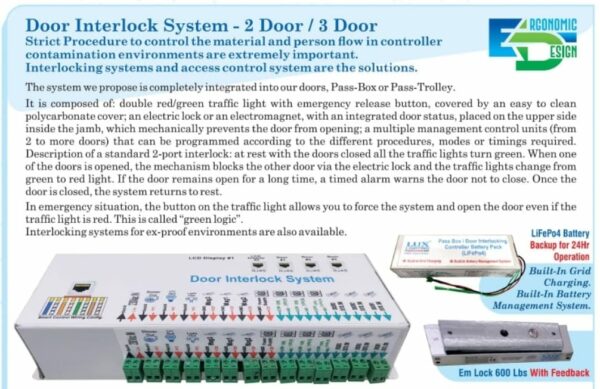Everything you need to know about Door Interlock System

Everything you need to know about Door Interlock System
It is rightly said that the doors we open and close on a daily basis determine our life. To be sure, doors are critical assets when it comes to safeguarding a building or any other structure against trespassers or threats. Consider a bank; the manager must rely on the doors and associated locks to safeguard anything held inside the bank’s lockers. With regard to the doors, the manager can blindly rely on the fitted locks, requiring no personal action.
Over the years, door interlocking systems have been the preferred method of security; the days of guards stationed at the entrance are long gone. Over the years, the variety of risks has expanded significantly, and one has begun to rely more on robots and technology than on a human worker.

What material is it constructed of?
A door interlock system consists of the following components: a double red/green traffic light with an emergency release button, protected by an easy-to-clean polycarbonate cover; an electric lock or an electromagnet with an integrated door status, installed on the upper side inside the jamb, mechanically preventing the door from opening; and a multiple management control units (from two to more doors) that can be programmed to correspond to the various procedures, modes, or timings required.
A conventional two-port interlock is as follows:
When the doors are closed and the vehicle is at rest, all traffic lights turn green. When one of the doors is opened, the mechanism prevents the other door from being opened via the electric lock, and the traffic lights change from green to red. If the door is left open for an extended period of time, a timed alarm alerts the user not to close it. Once the door is shut, the system returns to normal operation.
In an emergency situation, the button on the traffic light enables you to override the system and open the door regardless of whether the traffic light is red. This is referred to as “green logic.”
Additionally, interlocking solutions for use in ex-proof locations are provided.
Door interlock system characteristics

All attachments, traffic lights, and sensors are flush mounted inside the door jamb. When used with brick wall/plasterboard doors, these accessories are concealed within an exquisite aluminium foundation.
Keypad interface with illumination: Traffic light equipped with a button LED lights in red/green with clear transit indications. Emergency release button integrated.
Proximity sensor- Unlock the door by simply “passing your hand” a few centimetres in front of the proximity touch sensor. Door Sensor with LED Backlight for Infrared No-Touch EXIT Button Switch, 12V DC
Code access control with code- Enables allowed admissions solely through the entry of an alphanumeric access code programmed on the keypad.
Card reader for proximity badges – For approved entry only using programmed and personal proximity badges. Additionally, a platform and applications for remote access are offered.
Real-time access control. RFID Keypad Access Control Machine, EM Card Reader for Door Access Control System Keypad for RFID Access Control
Code access control with code- Enables allowed admissions solely through the entry of an alphanumeric access code programmed on the keypad.

Biometric/fingerprint- Only approved accesses are permitted with the use of programmed and Fingerprint Access Control. Additionally, a platform and software for real-time remote access control are offered.
Access control by code – For permitted admissions only with the entry of an alphanumeric code
The keypad can be programmed with an access code.
Fingerprint and facial recognition- Only authorised entries are permitted with the use of
Access Control with configurable Fingerprint and Face Recognition. Additionally, a platform and software for real-time remote access control are offered.
Door interlocking systems have a variety of applications.
There are numerous uses for door interlocking systems, most notably in locations where security is paramount, such as banks, shops, malls, and educational institutions. They are most noticeable in airports and offices, where every entry and leave must be monitored 24 hours a day. Apart from these applications, door interlocking systems are frequently used in clean rooms, where they are required by industry standards. This assures compliance with applicable standards and ensures that the product’s quality stays unaffected by external influences by providing security.
Metal detectors and sensors are required in public venues such as malls, where a big crowd congregates, but a door interlock system is all that is required. With features that alert the environment and send out an SOS, as well as the ability to detect theft or guns, a door interlock system, while simple, makes tracking and securing easier. In the event of an emergency, when power failure is a typical occurrence, door interlock systems are designed to operate in practically any scenario. Their emergency override feature enables them to be manually opened or closed to facilitate evacuation in the event of a fire.
On the other hand, correctional systems are considered the best example of how a door interlock system works. Where each entry and exit must be monitored to ensure no accidents or escapes occur, a door interlock system greatly assists the judicial system in these instances. The interlock system simplifies the job significantly by providing several alarm features and detecting practically every potential detail.




